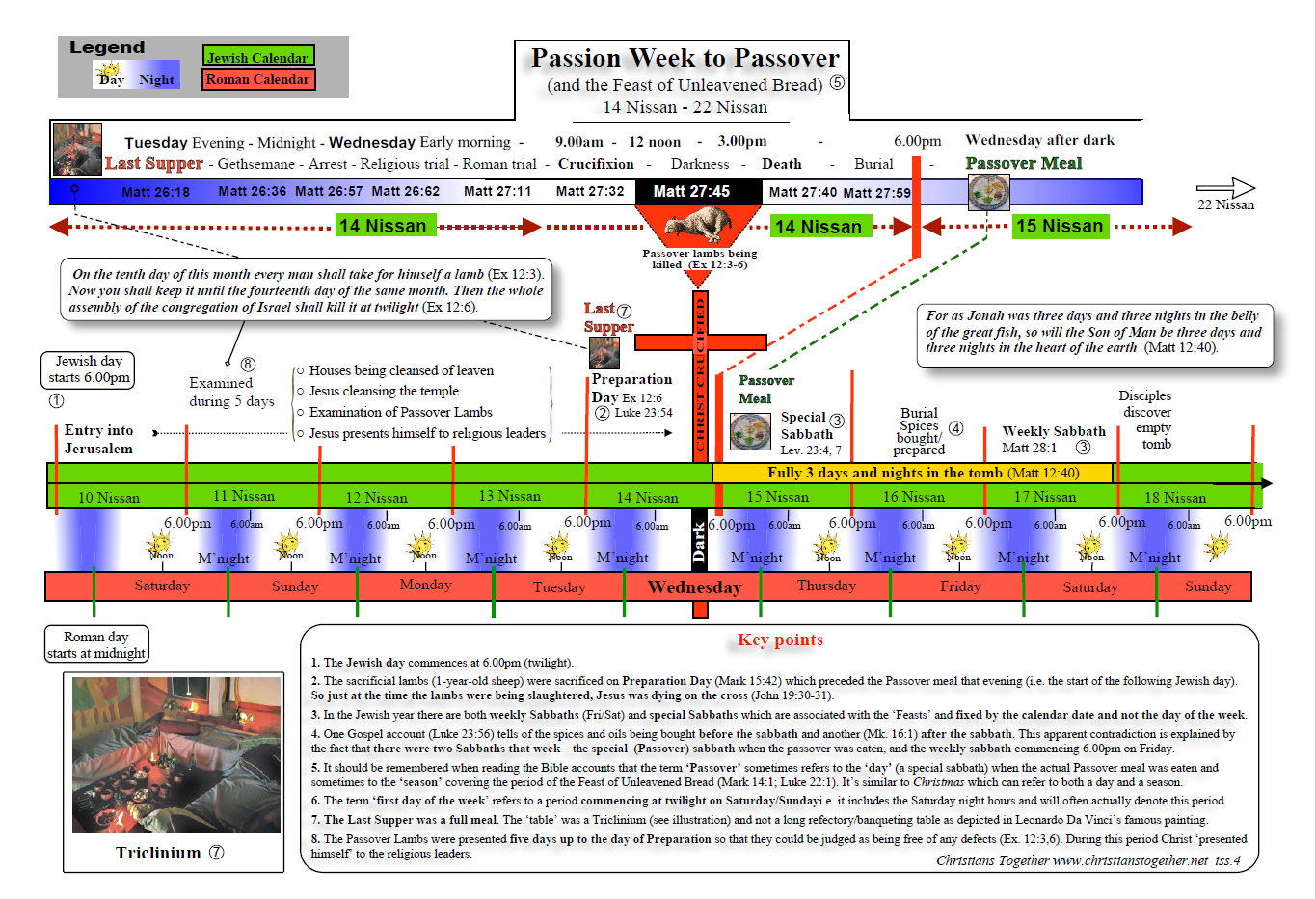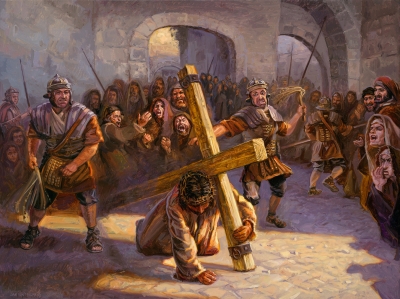The Passover Meal (Seder) embodies many spiritual truths concerning God's plan of redemption through Jesus Christ. However traditional church teaching (crucified Friday: resurrected Sunday) cannot be supported from a careful study of the Bible; and obscures the immaculate chain of events during the last week of Christ's life.
This Passover (Pesach) Jewish families will gather around a festive table for the Seder (telling of the story and meal). The story of the Passover will be told from the Haggadah (a Jewish religious text), explaining the story of Moses and the Exodus – how the Jewish people were freed from slavery in Egypt.
Accounts are given of Moses confronting Pharaoh and the ten plagues, how the first-born Israelites were spared by the blood of the lamb, and how God parted the Red Sea and delivered the Jewish people from slavery and bondage in Egypt.
A veil over their eyes
However, most Jewish people do not know (or do not understand/will not accept) that Jesus’ blood was shed on Passover 2,000 years ago, delivering them from spiritual bondage and giving them eternal life. And the rabbis forbid the reading of Isaiah Chapter 53, which speaks of Jesus as the suffering servant (cf John 12:40).
And while Gentile Christians rightly focus on the price paid at Calvary and the joy of the subsequent resurrection, there is – in traditional teaching – an anomaly which effectively obscures the full wonder relating to the amazing symmetry of all the events which took place over that momentous Passover season.
A lamb without blemish
Part of the biblical Passover practice was that the lamb which would be used for the Passover was to be set aside on the 10th day of the month of Nissan (Ex 12:3). It was then to be tested until the 14th day (Ex 12:6) to be certain it was without spot or blemish before it was killed.
Jesus, as the Passover Lamb, was also set aside on the 10th day of Nisan, because it was on this day that He entered Jerusalem, fulfilling the prophecy in Zechariah 9:9. This is therefore the true significance of His triumphal entry: the occasion Jesus set Himself aside as the Passover Lamb. Jesus was tested from the tenth day until the fourteenth day of Nisan by the Pharisees, the Sadducees, the Scribes, and the Herodians. By answering all of their objections and questions, Jesus (the Lamb of God) clearly showed that He was without spot and without blemish.
Prophecy fulfilled
He was later crucified at nine o'clock in the morning, at the same time as the special Passover animals (lambs or he-goats) were being killed as a sacrifice on the Temple compound.
Just as the Jewish leaders were very careful that not a single bone of the Passover lamb was broken, John 19:36 points out that neither was a single bone of Jesus broken, whether during His scourging, the crucifixion itself, or by the Roman soldiers who always broke the victim's legs.
Easter myths obscure the true wonder of it all
“For as Jonah was three days and three nights in the belly of a huge fish, so the Son of Man will be three days and three nights in the heart of the earth” (Matt 12:40) Jesus was crucified on Wednesday, not Friday.
Church tradition teaches that Jesus was crucified on Friday and rose again early on Sunday morning.
This contradicts the passages which tell us that Jesus would be 3 days and 3 nights in the grave (e.g. Matt 12:40; 26:61; 27:63). And suggesting (in this case) that ‘a part of a day is equal to a whole day’ does not represent what is clearly written.
The keys to understanding the (Passover) timeline of Jesus’ last week lie in the knowledge that:-
- The Jewish ‘day’ ran from twilight on one day until twilight the next. For the Jews the evening that Jesus died was actually a new day.
- Passover was both a ‘day’ and a ‘week’. The term ‘Passover’ was applied both to a single day and also to a ‘period of days’, in much the same way as we talk about Christmas as being a ‘day’ but also a ‘season’. The Passover day (commencing at sunset on 14 Nisan) was at the commencement of the seven-day Festival (Feast) of Unleavened Bread (15 - 21 Nisan: Lev 23:6; Num 28:17) and ‘Passover’ became the name for the entire festival. (Luke 22:1).
- The Passover lambs had to be tethered for four days before they were killed so that they could be carefully examined for any blemishes, and to allow that period of time to elapse so that any hidden defects would become apparent. If indeed Jesus was crucified in the middle of the week, this four-day period, when he was being ‘examined’ by the religious leaders, would exactly coincide with the time during which the sacrificial lambs were undergoing scrutiny (Ex 12:3-6).
- There are both weekly and annual sabbaths in Old Testament (Jewish) law. In addition to the weekly Sabbaths (which always fell on a Friday/Saturday) there were also yearly Sabbaths (High Holy Days) which fell on a specific date during a specific month e.g. Passover (day) was/is an annual ‘sabbath’ (Jn 19:31) and always falls on 14 Nisan (Lev. 23:5-7) – irrespective of what day of the week that is in any one year. So (for instance) at one of the Feasts there would regularly have been two sabbaths within a seven-day period. This reconciles the apparent contradiction in the Gospels whereby Luke’s account describes the two Marys and Salome preparing the burial spices and perfumes before the Sabbath (Luke 23:56), while Mark’s gospel places this activity after the Sabbath(s) (Mark 16:1 and Note 1.); i.e. the ladies did their preparation work after the (annual) Passover Sabbath (14 Nisan) but before the weekly Sabbath (Friday 6.00pm - Saturday 6.00pm) and in advance of them going to the tomb early on Sunday morning only to find that Jesus had already been resurrected.
Thus, Jesus was crucified earlier in the week (Wednesday); and He would have been dying on Calvary’s cross on ‘Preparation Day’ (Luke 23:54) at precisely the same time as the High Priest priests would have been sacrificing the passover lambs for the nation in the temple precincts. This satisfied the Jewish leaders’ desire to avoid having Jesus killed during the Feast (Matt. 26:5). The High Priest concluded the 2-day slaughter of the sacrifices at 3.00pm on 14 Nisan with the cry: “It is finished” (cf John 19:30). What a wonder of God's precision and of that amazing symmetry. Jesus was then buried before the annual sabbath (John 19:31) – the day of Passover which commenced at 6.00pm on that same day. He then rose three days later, after the weekly sabbath (Mark 16:9), fulfilling the typology of Jonah to which Jesus had referred. Click on image below for chart showing events of Passion Week  Easter week
Easter week
The Firstfruit(s) of our Salvation
Since Jesus was crucified on Preparation Day (John 19:31 et al) – the day before Passover – and was resurrected three days and nights after He was crucified, Jesus arose from the grave on the seventeenth of Nisan, the day of the festival of First Fruits. In fact, Jesus is called the first fruits of those who rise from the dead.
“But now is Christ risen from the dead, and become the firstfruits of them that slept. For since by man came death, by man came also the resurrection of the dead. For as in Adam all die, even so in Christ shall all be made alive. But every man in his own order: Christ the firstfruits; afterward they that are Christ’s at His coming” (1 Cor 15:20-23).
This year, 14 million Jewish people worldwide will celebrate Passover in their homes with family and friends, gathered around the table for the Seder meal, retelling the story of Passover, but without the revelation of its ultimate significance. As one Jewish believer (in Yeshua) has written:
“No one has a clue as they read about God's deliverance in Egypt that the Passover lamb has been fulfilled in Jesus! Even though the Jewish people are known as the ‘People of the Book’, most know little, if anything, about the Messianic prophecies. The rabbis do not investigate or discuss the Messianic prophecies, and they ignore what Moses says: ‘without the blood atonement, there is no redemption of sin.’” (Lev. 17:11)
What began at the first Passover was later fulfilled by Jesus, once and for all! Moses stood up to Pharoah saying: ‘Let my people go!’ so that the Jewish people would be freed from bondage and they could worship God in freedom.
Today Moses is not here, but the Gentile church is required by God to reach out to the Jewish people so that they can be delivered from eternal death and set free by knowing Jesus the Passover Lamb, who gives freedom and eternal life. And one day the scales will be removed from the Jewish eyes and “they will look on Me whom they have pierced; and mourn for Him as an only son” (Zech 12:10).
He is Risen. Hallelujah!
Amen. Come Lord Jesus!
Endnotes
1. In Mark 16:1 the Greek word for 'sabbath' is in the plural i.e. the text should read: 'When the Sabbaths (plural) were over...'
2. The Last Supper was eaten the night before the Jews celebrated the Passover. It was a full meal and Jesus was - figuratively speaking - the sacrificial lamb at the table.
Colin Wilson is on the editorial board of Prophecy Today and is Editor of the website Christians Together.




